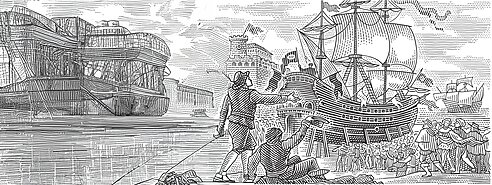During the European age of exploration and discovery, perhaps no other city better epitomized the spirit of the times than Seville, Spain. Today we know Seville as the sunny capital of the region of Andalusia. But during the century following the Iberian conquest of America, Seville was one of the most important cities in Europe.


Watch this 6‑minute lighthearted video about a couple’s tour of Seville. It will give you an idea of its location and a general feel for the city.
When you’re done watching, with partners, in small groups, or as a whole class, respond to the following questions:
- It seems that many shops in Seville are closed on Sunday. Use your background knowledge: What are some of the social and cultural reasons for Sunday being a day off for most people in Seville?
- How do the couple’s choice of transportation and their predicament in Seville represent current trends in globalization and technology?
- The architecture of Seville is a syncretic blend of different styles. Which two cultures have had the biggest impact on the buildings and urban design—such as plazas, courtyards, and fountains—of southern Spain?
Questions for Reading, Writing, and Discussion
Read the article, then answer the following questions:
- The article mentions three UNESCO World Heritage sites, one of which is now called the General Archive of the Indies (formerly the Merchants’ Exchange House). This iconic building symbolizes the economic system that Spain used during its Golden Age. Name that economic system and some of its defining characteristics.
- In addition to the new kind of ship called the galleon, what other types of navigational technology did Portuguese and Spanish mariners use in their voyages of exploration? Where did much of this technology originate, and which historical and geographical factors allowed Iberians to capitalize on it?
- Describe the public‐private arrangement created to fund Magellan’s voyage.
- In your opinion, what were the most important outcomes of the Spanish expedition that circumnavigated the globe in 1519–1522? Explain at least three outcomes.
Extension Activity/Homework
- Compare Seville with another city.
Follett describes how Seville benefited from being at the center of a global trade network during the 1500s. She also mentions that Islam was outlawed in 1502 and that enslaved Africans could be seen in Seville during the period. These facts show us that although Spain possessed a rich cosmopolitan culture, religious intolerance and extreme human rights abuses also characterized Spanish society at that time.
Historians caution against judging past societies through the lens of modern values. Nevertheless, it can be useful to compare and contrast the practices of diverse civilizations to see how they dealt with universal problems.
The Centers of Progress series has profiled several cities during their respective “golden ages.” Choose one of the following cities and read its associated article. Then, complete the table below. Compare your chosen city to Seville for each of the criteria.
Chang’an (Trade)
Hangzhou (Paper Money)
Florence (Art)
Edinburgh (Scottish Enlightenment)
Vienna (Music)
Amsterdam (Openness)
| Seville during the 1500s | ________during the ________ | |
|---|---|---|
| Religious toleration | ||
| Economic freedom | ||
| Equality for all people under the law | ||
| Respect for the rights of women and ethnic minorities | ||
| Representative forms of government |
- Write an essay in response to a prompt.
Follett writes, “Europe’s great powers competed for mastery of oceanic trade avenues and raced to be the first to discover promising sea routes and uncharted lands.”
Some historians cite the competitive multistate system of Western Europe as key to those states’ success in the pre‐modern period. They argue that unified civilizations such as China under the Ming dynasty lacked such competition and thus did not have an incentive to innovate.
Write a short essay answering the following prompt:
Describe the extent to which political fragmentation played a role in Western European innovation, exploration, and conquest during 1450–1750.
Be sure to provide context, include a thesis statement, and cite evidence both from the article and your own background knowledge to back up your claims. - Create an architectural photo story.
Choose one of the three examples of monumental architecture in Seville: the Mudéjarstyle Alcázar royal palace, the Seville Cathedral, or the General Archive of the Indies.
Create an architectural photo story about one of the three buildings using Google Slides or PowerPoint. Describe the main elements of the building, including its dimensions, its significance to Spanish and world history, unique aspects of its style and construction, and important works of art and historical figures associated with it.
Imagine that you are telling a story about the building through photography. You may use any source for the images, but you must cite them.